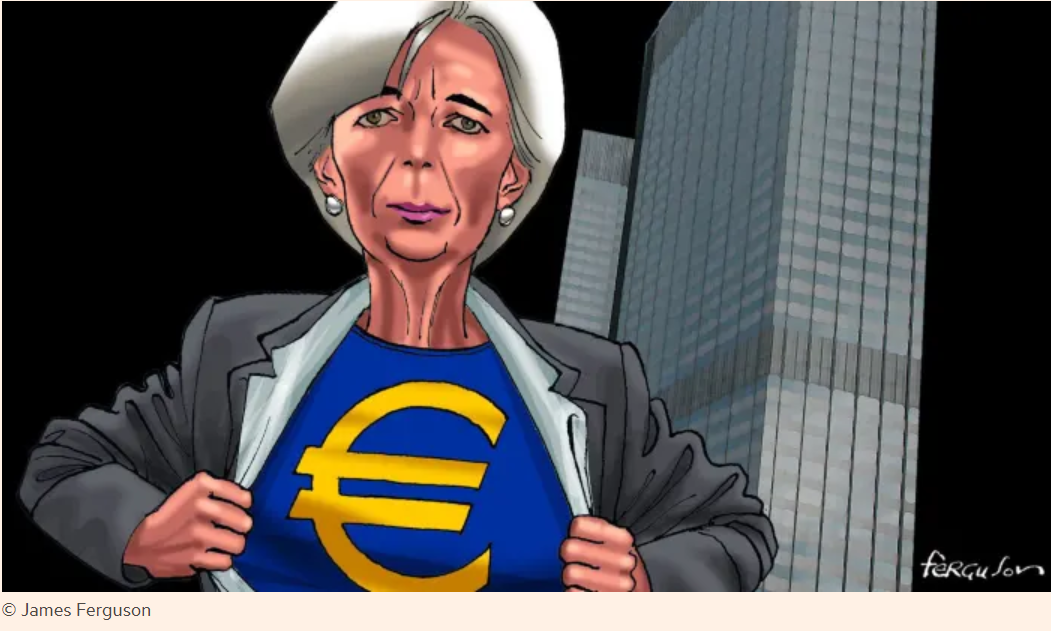ECB har for første gang givet et officielt svar til den tyske forfatningsdomstol i Karlsruhe efter domstolens skarpe kritik af ECBs nye opkøbsprogram PEPP. ECB fastholder sin policy med opkøbsprogram og gør det klart, at centralbanken har “modet til at handle”, når der er behov for det, også med flere opkøb. ECB har med opkøbsprogrammet hjulpet coronaramte lande, og det har har virket, skriver ECB, men understreger også, at det er ekstraordinære løsninger. ECB vil med sin pengepolitik og opkøbene bidrage til at reducere det europæiske rente-spread. ECB har kun indirekte svaret forfatningsdomstolen, men ved at henvise til den ekstraordinære situation forklarer ECB, at centralbanken ikke har ændret sin overordnede strategi. De officielle tyske reaktioner på affæren tyder på, at sagen er “endt uden drama”.
ECB Watch: Courage to act
The ECB is here to close spreads and the PEPP can be expanded further, if needed. A lot of words were used to satisfy the German Constitutional Court.
The accounts of the 3-4 June Governing Council meeting did not offer any new clues as to what lies ahead for monetary policy. Still, the overall impression is that the ECB is here to close spreads and ease financial conditions by potentially expanding the Pandemic Emergency Purchase Program (PEPP) further, if needed.
Discussions about acting vs waiting and a smaller vs larger increase in the PEPP fell out in favour of earlier and larger to signal discontent with the low medium-term inflation projection as well as to prevent a renewed tightening of financial conditions, suggesting that the Governing Council remains willing and able to act – or as it was put in Bernanke’s memoirs – still has the courage to act.
Financial conditions and inflation expectations
Two main factors caused the increase in the PEPP envelope at the meeting: “First, the medium-term outlook for price stability was threatened by the fallout from the coronavirus crisis […] Second, financial conditions for the euro area as a whole were significantly tighter compared with the period before the pandemic, whereas the growth and inflation outlook called for easier financial conditions”.
The ECB clearly sees the pandemic as a temporary shock, which was why the PEPP was chosen over other instruments, and should be seen as a ceiling in the sense that “in the event of significant upside surprises to the outlook, the full envelope would not need to be used”. Moreover, “once the pandemic shock to the inflation path had subsided, the monetary stance could again be controlled by calibrating the Governing Council’s pre-crisis suite of policy instruments.”
The link between the temporary nature of the shock from the pandemic and the temporary nature of the PEPP could imply that more permanent issues such as the de-anchoring of longer-term inflation expectations might call for other instruments down the line. In the discussions about depressed inflation expectations, the accounts read: “It was argued that the elevated probability of inflation remaining below 1% according to market-based indicators suggested that market participants’ inflation expectations might have become less well anchored,” suggesting that this will be a huge topic once the big fire has been put out.
In defence against Karlsruhe
The account restated the essential role of the bond purchases as a policy tool in the Euro area, and was clearly targeted to the German Constitutional Court. Indeed, the effectiveness and efficiency of the expansion of the PEPP, and past decisions on purchase programmes, were argued for. According to the ECB, the pros clearly outweigh the cons.
In an indirect response to the German Constitutional Court which has demanded a proportionality assessment of the ECB’s purchase programme, an elaborate defence of the proportionality of the asset purchase programmes was laid out in the account as well, even bringing the discussion back to January 2015.
The ECB argues that “There was now ample evidence from an exhaustive literature showing that asset purchase programmes in general and the PSPP in particular had proven effective in achieving their intended effects on the euro area economy and thereby in maintaining price stability.” and “the overall evidence underpinned the view that the PSPP had had a positive impact on macroeconomic outcomes, confirming the assessment that it was a policy measure that was effective in putting upward pressure on inflation and inflation expectations as intended.”
The ECB also took the opportunity to once again explain to the German hawks that “the challenges of a low interest rate environment mainly arose from the structural factors driving the decline of interest rates, while monetary policy had only contributed to these effects and was clearly not the main factor behind them.”
According to a Reuters story yesterday, the ECB has also handed over unpublished documents reinforcing its policy decisions to Bundesbank Governor Weidmann, for him to pass them on to the German parliament and government. This would be in line with earlier comments this week from Germany’s finance minister that the issue between the ECB and the German Constitutional Court is about to be resolved “without drama”.
Market impact
Rate cuts remain low on the list of likely instruments to be deployed. “High uncertainty and heightened risk aversion would weaken the transmission of policy rate cuts to the market reference rates that mattered for the pricing of credit to households and firms, especially in the context of a temporary shock. In this environment, asset purchases were more efficient at easing funding conditions and thereby the lending rates that mattered for the real economy.”
The ECB will expand the PEPP and do TLTROs on sweetened terms before acting on the policy rates, which should gradually lead to pricing out the remaining rate cut expectations once economic indicators point to a clear recovery.
The ECB is still here to close spreads: “It was argued that the PEPP was the best available instrument for lowering the medium and long-term interest rates which mattered most for the real economy. Expanding the PEPP would help to bring the sovereign bond yield curve more closely into line with the risk-free curve. This in turn would support the transmission of monetary policy to the interest rates applicable to households and businesses, to the extent that sovereign bond yields acted as a benchmark for the pricing of loans and market-based credit instruments. It was also remarked that increasing the size and duration of asset purchases would contribute to containing overall uncertainty, thereby supporting the recovery of the euro area economy.”
With ECB focus as well as TLTRO and PEPP money, peripheral- and semicore should continue to be supported.




